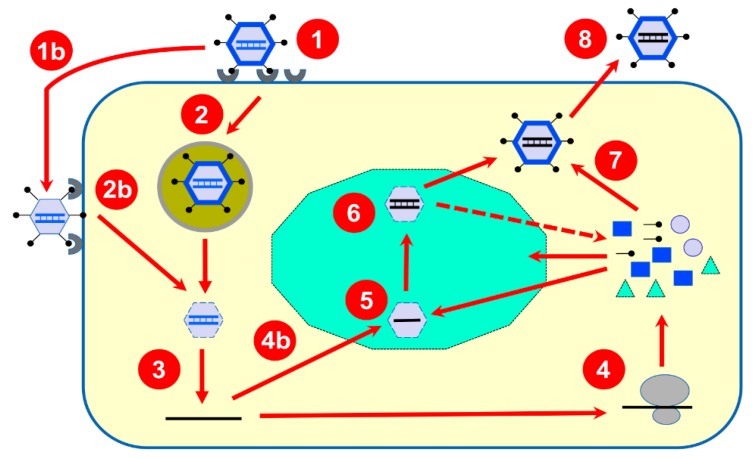Figure 1.
Summary of the reovirus multiplication cycle. Upon binding to different host-cell receptors (1), the reovirus virion containing the double-stranded RNA genome (in blue) is internalized by endocytosis (2) and transported towards late endosomes (2); they are then partially disassembled to produce transcriptionally active cores that are released in the host-cell cytoplasm (3). Alternatively, due to the action of extracellular proteases, partially uncoated virions known as infectious subviral particles (ISVPs) are generated (1b) and can bypass endocytosis and penetrate the host-cell membrane (2b) also leading to transcriptionally active cores in the cytoplasm (3). These “parental” cores possess all required enzymatic activities to synthesize and release multiple copies of capped messenger RNA (in black) synthesized from the ten viral double-stranded RNA genome segments as a template. Released mRNAs are translated by the cellular machinery (4) to generate both structural and nonstructural proteins; alternatively, some copies (4b) will be recruited to viral inclusions (in green) made by viral proteins. One copy of each 10 viral mRNAs will be packaged by viral inner capsid proteins to form intermediate structures (5) where synthesis of the second strand will take place to generate newly formed double-stranded RNA genomes retained in “progeny” particles (6). These, more abundant particles, in turn, are believed to be responsible for the synthesis of the bulk part of viral mRNA responsible for viral proteins synthesis (as indicated by the dotted arrow). Outer capsid proteins will be added (7) to finalize viral particles assembly before release of fully assembled virions (8).

